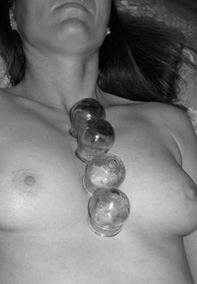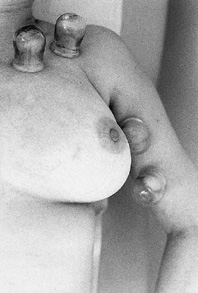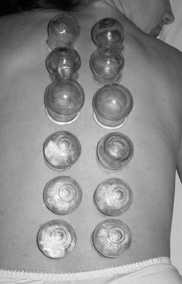Cardiovascular Disease
Coronary Heart Disease (Angina Pectoris)
Angina pectoris manifests in episodic painful, oppressive feeling in the area of the heart, retrosternal, or in the upper abdomen. The severe pain of angina pectoris can be caused by a variety of heart disorders, but is most commonly a sign of inadequate blood supply (hypoxia) of the heart muscle, as, for example, in a pathological constriction of the coronary arteries. Constriction of the coronary arteries can have different causes:
• Arteriosclerotic processes. Symptoms manifest especially after physical exertion.
• Nervous disturbances. A temporary spasmodic constriction of the coronary arteries, especially after states of excitation.
• Coronary insufficiency in ventricular hypertrophy. For example, in arterial hypertension or aortic stenosis, certain types of arrhythmia.
Symptoms
• Suddenly occurring “pain of annihilation” in the area of the heart, often radiating to the left shoulder and into the left arm. Occasionally also just mild pressure in the area of the heart or epigastrium
• Fearful feeling, dyspnea, accelerated pulse, arrhythmia.
• During attacks: cool, pale, often sweaty face with fearful expression. Occasional provocation of the pain by meals or cold. Sometimes nausea and urinary urgency directly after attacks.
• Duration of attacks: several minutes to half an hour.
Suggested Therapy
During attacks, administering nitrate preparations sublingually or as aerosol often offers instant relief. Cupping can obviously not replace nitrate preparations in this case. Nevertheless, nitrate preparations are unable to cause persistent vasodilation, so important in this disease, which is in turn possible with cupping (Figs. 9.1 and 9.2). Bachmann reports complete cure of angina pectoris with repeated cupping.

Fig. 9.1 Dry cupping:left parasternal.
• Initially, two to three treatments per week, to a total of 15, that is, the course of treatment lasting 5–7 weeks. Subsequently, one treatment every 3 weeks.
• Perhaps alternating with cupping massage on the left arm and intercostal area as well as the thorax and shoulder girdle and neck muscles.

Fig. 9.2 Dry cupping on the inside of the left arm and in the vicinity of the shoulder joint frontally, especially on tender points.
Supplemental Therapy
• Homeopathy. In this disease, a purely organotropic treatment is possible, in which therapy with constitutional remedies can become necessary. To prevent attacks, we must address the root condition. Depending on the root condition and constitution, a whole series of remedies can be considered.
• Phytotherapy. Preparations of special extracts.
• Autogenic training. General relaxation, stress reduction.
Abnormal Blood Pressure
Blood pressure depends on the strength of the heartbeat, the elasticity of the arterial walls, and the resistance in the capillaries. At the age of 20, the average values are 120 mm of mercury (mmHg) systolic and 80 mmHg diastolic blood pressure. Under certain circumstances, blood pressure decreases (hypotension) or increases (hypertension).
Low Blood Pressure (Hypotension)
Hypotension refers to chronic blood pressure values below 105/60 mmHg. This is a disturbance in the circulatory regulation, caused by insufficient strength in the heart, blood loss, or experience of shock in acute hypotonia.
Low blood pressure with tendency to circulatory insufficiency is less dangerous than high blood pressure. Hypotension occurs both in younger and older persons. The typical manifestations of this disease are triggered by insufficient circulation, especially in the brain.
Symptoms
• Low blood pressure in the seated or lying position.
• Reduced physical and mental productivity: fatigue, exhaustion.
• Blackout, dizziness, and fainting.
• Subjective coldness in the limbs, tinnitus, sleep disturbances, irritability.
Suggested Therapy
Most patients do not require medicinal therapy. Treatment with cupping leads to better circulation and lessens annoying symptoms (Fig. 9.3).
Supplemental Therapy
• Homeopathy. In low blood pressure, the patient’s general constitution is decisive. Nevertheless, the patient suffers from occasional episodes of fainting or collapse, which require a rapid response. You should therefore familiarize yourself well with collapse remedies. Remedy selection on the basis of constitutional aspects.
• Phytotherapy. Strengthening the heart muscle with hawthorn preparations.

Fig. 9.3 Dry cupping bilaterally along the thoracic vertebrae; alternating with cupping massage.
Alternating Therapy
• Neural therapy. Quaddle therapy with local anesthetics paravertebral in the heart segment.
• Physical therapy. Kneipp affusions. Physical activity.
High Blood Pressure (Hypertension)
Hypertension refers to a consistent increase (measuring the blood pressure two times daily for a week) in systolic blood pressure above 140 mm Hg and/or systolic blood pressure above 140 mm Hg. Even if only the systolic blood pressure is elevated, this must be judged as a pathological change.
Stay updated, free articles. Join our Telegram channel

Full access? Get Clinical Tree






